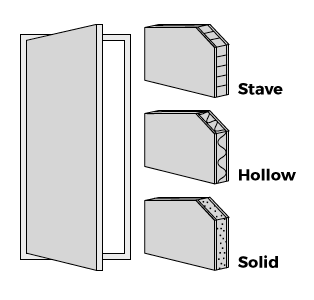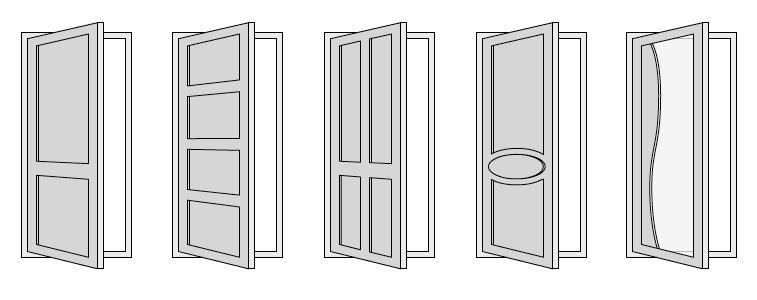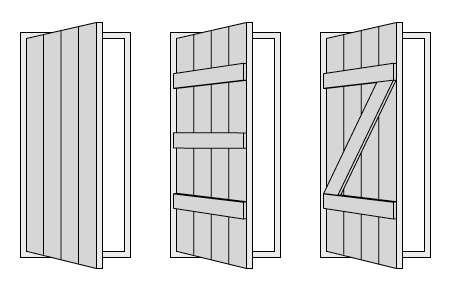
Cottage or Mexicano? Panel or Flush? If you’re confused by the different types of internal doors available to you, we don’t blame you! With so many different variations and styles, even the best of us can get a little confused.
Here at Express Doors Direct, we decided that it was about time to set the record straight. We explain what the difference is between the various styles of internal doors so you can choose the right doors for you.
Flush doors are the simplest of all door designs. They have plain facings on both sides, which means that are smooth and feature no patterns or panels. Typically, the facings will be sandwiched on either side of a core material; allowing you to keep up the appearance of solid wood doors, without the price tag.
 Flush doors can have one of three core; solid, hollow or stave. A solid core is exactly what it says on the tin. A solid sheet of material, such as particle board or foam, is used to completely fill the space between the two facings. The result is a flush door with extra strength, insulation, and sound-proofing properties.
Flush doors can have one of three core; solid, hollow or stave. A solid core is exactly what it says on the tin. A solid sheet of material, such as particle board or foam, is used to completely fill the space between the two facings. The result is a flush door with extra strength, insulation, and sound-proofing properties.
Hollow core flush doors feature only the most minimal of support between the door skin and the frame; often in the form of corrugated cardboard in a lattice or honeycomb formation. Stave core flush doors are the mid-point between solid and hollow. Internally, they are constructed from wooden slats stacked and fixed one on top of the other. The facings and lippings are then attached to the stack of wood to give you the appearance and rigidity of a solid wood door, without the weight or price tag.
Panel doors are probably the most common style of internal door that you will come in to contact with. Their simple silhouette means that they look great in almost any style of home. Despite their similarities, panel doors are available in a wide range of styles depending on how many panels you want. They are typically available in designs from two panels all the way up to twelve, although you may be able to find designs with more than this.
The panels can be either horizontally or vertically stacked; typically, the more panels the more traditional the appearance of the door.
Panel doors can be glazed or unglazed. Glazed variations may have a single, multiple, or all of the panels in glass. These are a great option for allowing more natural light to filter from room to room.

Cottage doors aren’t just for use in their namesake habitation; although they do look particularly spectacular in period homes. They may occasionally be called planked doors, or ledge and brace but the latter refers to a slightly different style, which we cover later.
Often made from oak, cottage doors are a hardy, rustic, style of door. Despite their traditional origins, they look fantastic in both traditional and contemporary homes. Once you know what you’re looking for, you’ll be able to spot a cottage door from a mile away. Cottage-style internal doors feature vertical planks which run the full length of the door. Sometimes these planks may run from edge to edge, other times they may be encased within a border. Either way, they’re still cottage doors.

Ledged doors feature the same vertical construction as cottage doors but are then reinforced on one side with horizontal ledges. The location of the ledges on the door will depending on how many ledges there are. If you have two it’s likely that you will find one at the top and one at the bottom, three will be evenly spaced between the top and bottom, and so on…
Ledge and brace doors are a variation of the ledged door but with the addition of the brace. As the ledge runs horizontally, the brace runs at an angle connecting the corner of one ledge to the opposite corner of the other at a 45-degree angle.
It’s not just the style of door that needs your consideration, you also need to decide whether you want finished, unfinished, or primed, too! To clear up any confusion about what these different finishes mean, we’ve explained them below.
Fully finished doors are ones that require no additional work aside from the handles and hinges being fitted and the door hung. They have had their final coats of paint or stain and are ready to be installed in your home immediately.
Unfinished doors require a little extra work before you can hang them. Think of unfinished doors a bit like a blank canvas, just waiting for you to decide on your preferred finishing product. From varnishes to wood oils, waxes to stains, you have total control over the finished look of the door which is great if you’re trying to match your doors to existing woodwork, or just fancy trying something a little different.
Primed doors can come in any style; panel, cottage, glazed, unglazed. The name refers to the fact that these doors have been pre-primed, often in white allowing you to paint them your desired colour without having to sand and prime yourself. Our white primed internal doors are finished to such high quality that you can hang them as they are for an ultra-bright, contemporary look.
